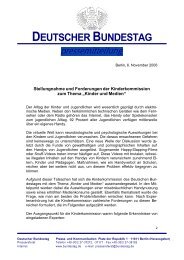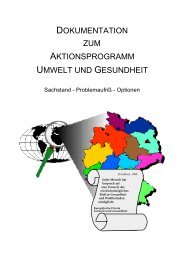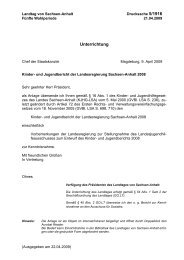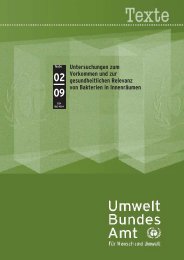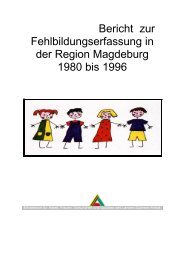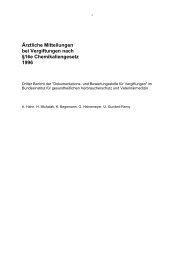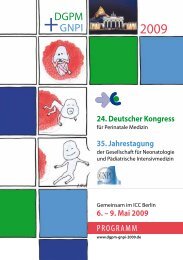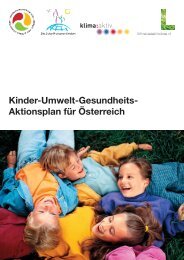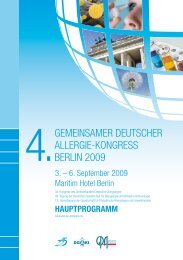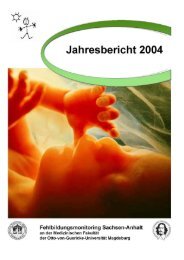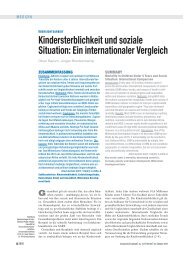Wiener Gesundheits- und Sozialsurvey Vienna Health and Social ...
Wiener Gesundheits- und Sozialsurvey Vienna Health and Social ...
Wiener Gesundheits- und Sozialsurvey Vienna Health and Social ...
Erfolgreiche ePaper selbst erstellen
Machen Sie aus Ihren PDF Publikationen ein blätterbares Flipbook mit unserer einzigartigen Google optimierten e-Paper Software.
aged 74 <strong>and</strong> above are former smokers. The survey<br />
fo<strong>und</strong> nicotine consumption more widespread among<br />
less educated people <strong>and</strong> those in lower positions. The<br />
share of non-smokers rises with education <strong>and</strong> career<br />
level. This is also reflected by the fact that the biggest<br />
group of smokers by far is fo<strong>und</strong> in districts with a high<br />
percentage of blue-collar workers <strong>and</strong> foreigners. The<br />
number of smokers is lowest in districts with the highest<br />
income level. Both men <strong>and</strong> women start smoking at a<br />
much earlier age than used to be the case, the average<br />
age for first-time smokers being 15. As a rule, the older<br />
the interviewees, the later in life they started smoking.<br />
In total, more men than women have smoked hashish.<br />
All the 45 to 59 year old men reported to have tried<br />
hashish at least once in their lives: 84 percent claim to<br />
have done so earlier in life, while 16 percent did so within<br />
the course of the previous month. On the whole, hashish<br />
consumption is most frequent among people of higher<br />
classes living in districts with the highest income level.<br />
The frequency of voluntary screening tests increases<br />
with age with no apparent gender differences, the exception<br />
being people aged 74 <strong>and</strong> above who frequently already<br />
are in medical treatment. Young people are seldom<br />
interested in voluntary screening tests, approximately<br />
half of them have never had this done. There<br />
seems to be no direct link between the level of education<br />
<strong>and</strong> the frequency of voluntary screening tests. Approximately<br />
30 percent of women who have completed an apprenticeship<br />
or have graduated from secondary education,<br />
<strong>and</strong> equally as many men who have completed an<br />
apprenticeship or have graduated from university claim<br />
to have had voluntary screening tests in the past year. 50<br />
percent of men with compulsory schooling only have not<br />
had voluntary screening tests. Special screening tests for<br />
women, such as pap smears or mammography, are<br />
<strong>und</strong>ergone more frequently with increasing age, with a<br />
noticeable drop in testing frequency among women aged<br />
75 <strong>and</strong> above. 31 percent of young women have not <strong>und</strong>ergone<br />
any of these tests, 74 percent have never had a<br />
mammography. The frequency of pap smears increases<br />
with the level of education, while the same cannot be<br />
said for the frequency of mammographies. 40 percent of<br />
women with an apprenticeship had a mammography in<br />
the course of the past year, while university graduates<br />
are least likely to have had this kind of examination performed<br />
(40 percent have never <strong>und</strong>ergone this test). Only<br />
50 percent of women without qualifications had a pap<br />
smear in the course of the past year. Women with quali-<br />
WIENER GESUNDHEITS- UND SOZIALSURVEY<br />
SUMMARY AND CONCLUSIONS<br />
fications had mammographies performed most frequently<br />
in the past year, 39 percent of university graduates<br />
did not. For men, the frequency of prostate examinations<br />
increases with age <strong>and</strong> professional status.<br />
Women <strong>and</strong> elderly people tend to take medication as a<br />
remedy more often than others interviewed. Most frequently<br />
used are antihypertensive medication, particularly<br />
by men <strong>and</strong> women aged 60 <strong>and</strong> above, followed by<br />
cardiac medication for people aged 74 <strong>and</strong> above. It is<br />
interesting to note that men tend to rely on cardiovascular<br />
medication slightly more often than women, which is<br />
not true for other kinds of medication. Painkillers as a<br />
remedy for muscle, bone, tendon or joint aches are most<br />
frequently used by women aged 60 <strong>and</strong> above. Younger<br />
women <strong>and</strong> men tend to use other types of painkillers,<br />
while hypnotics <strong>and</strong> sedatives are most frequently taken<br />
by men <strong>and</strong> women aged 74 <strong>and</strong> above. Young men are<br />
most likely not to take any medication at all. The majority<br />
of people in <strong>Vienna</strong> rely on their doctors for advice on<br />
how to administer medication, yet most of them refer to<br />
the enclosed instructions for information on side effects.<br />
Only half of women aged 74 <strong>and</strong> above ask their doctors<br />
for advice on side effects, 16 percent to 18 percent never<br />
ask about side effects.<br />
In the past three months of reporting, the majority of<br />
people interviewed turned to their general practitioners<br />
at the first sign of malaise, the more often the older they<br />
were. Home visits <strong>and</strong> in-patient treatment were made<br />
use of mainly by people aged 74 <strong>and</strong> above. Men above<br />
the age of 59 <strong>and</strong> women above the age of 45 tend to consult<br />
specialists more often than others. Dentists are most<br />
often visited by younger people (18 percent), 60 percent<br />
of young men <strong>and</strong> 50 percent of young women did not<br />
consult a doctor at all in the period of reporting.<br />
Other health services were hardly made use of in the<br />
past three months; 95 percent to 97 percent of young<br />
men <strong>and</strong> women sought no advice at all. The majority of<br />
those who did visited physiotherapists, followed by psychotherapists.<br />
These services are more popular with<br />
women than with men, as is alternative medical treatment.<br />
Dentists were visited fairly often during the past five<br />
years. More than 50 percent of the people interviewed reported<br />
to have visited a dentist five times or more during<br />
that time, the exception being people with compulsory<br />
education only. The latter form the largest group (15<br />
37



